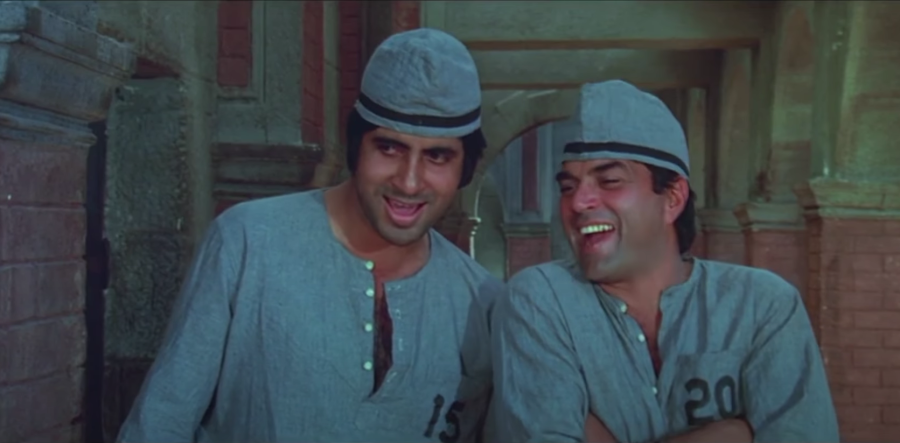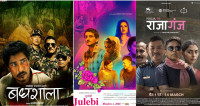Movies
‘Sholay’ at 50 echoes across borders
The iconic train ambush scene—with dacoits falling in slow motion, bullets slicing through dust and light—set a new benchmark for spectacle.
Rajeev Shrivastava
Released in 1975, Sholay marks 50 years since its debut–five decades of cinematic glory that few films anywhere in the world can rival. More than a movie, Sholay became a cultural watershed, a touchstone in Hindi popular cinema whose echoes continue to reverberate across generations–and across borders.
At Mumbai’s iconic Minerva Theatre, Sholay ran uninterrupted for five straight years, from 1975 to 1980. Audiences returned repeatedly, mouthing its dialogues, humming its songs, and immersing themselves in the lives of Jai, Veeru, Basanti, and Gabbar. Its soundtrack, released on cassette and LP vinyl, shattered sales records. In many Indian neighbourhoods, simply playing the film’s music over a loudspeaker was enough to gather a crowd, eager to relive its magic.
The only precedent to this level of frenzy was Kismet (1943), which ran for 192 weeks nearly 3.7 years at Calcutta’s Roxy Cinema, earning Rs 3.32 million at the time (roughly Rs 500 crores today when adjusted for inflation). While Sholay dazzled with its scale and ambition, ironically, its fiercest box office competition came from an unexpected quarter: Jai Santoshi Maa, a modestly budgeted devotional film that became a surprise blockbuster in the same year. That both films could dominate simultaneously highlighted the breadth of Indian cinematic taste – and the democratic unpredictability of popular success.
Yet Sholay’s triumph was not confined to the domestic box office. Its influence extended far beyond Indian shores–nowhere more so than in Iran.
The Iranian love affair with Sholay
To mark Sholay’s 50th anniversary, an Iranian newspaper devoted an entire page to the film–a remarkable tribute from a nation with its own rich and distinctive cinematic tradition. The piece emphasised how the film’s central theme–an unbreakable friendship between two outlaws–and the unforgettable villainy of Gabbar Singh (popularly known in Iran as “Jabbar Singh”) became deeply woven into the collective memory of Iranian audiences.
So iconic was Amjad Khan’s portrayal that acclaimed Iranian actor Navid Mohamadzadeh once channelled Gabbar Singh in a film role–mimicking his looks and mannerisms. The performance drew widespread attention after a post about it was reshared by the official X (formerly Twitter) account of the Embassy of the Islamic Republic of Iran in India (@Iran_in_India), with the caption: “Sholay turns 50, and Iran still remembers.” In a world where cultural bridges can seem fragile, the gesture stood as a powerful reminder of how cinema can transcend borders, politics, and language.
The Indo-Iranian cinematic connection, however, dates back much earlier. Before the 1979 Islamic Revolution, Indian films were immensely popular in Iran. Raj Kapoor’s Shree 420 (1955), with its potent mix of social satire, romance, and moral conflict, was the first Hindi film to truly captivate Iranian viewers. Later, Sangam (1964)–Kapoor’s first Technicolour film–enchanted audiences with its emotional storytelling and exotic European locales. Both films were dubbed into Persian and distributed by SP Hinduja. At the Tehran premiere of Sangam, Kapoor’s popularity was so overwhelming that he had to be escorted out in a prison van to avoid being mobbed.
By the time Sholay arrived, Iranian audiences were already familiar with the faces of Amitabh Bachchan, Dharmendra, and Hema Malini. As recently as 2014, India Today’s Raju Nagrajan reported that Sholay was still running in Tehran–for the fifth consecutive month–almost four decades after its release.
A Western with an Indian heart
Sholay’s cinematic DNA is unmistakably global in inspiration. The Spaghetti Westerns of Sergio Leone left an indelible mark on its visual style: sweeping vistas, brooding silences, stylised shootouts, and intense close-ups. The massacre of Thakur Baldev Singh’s family bears eerie resemblance to the annihilation of the McBain family in Leone’s Once Upon a Time in the West (1968). Likewise, The Magnificent Seven (1960)–itself an American remake of Kurosawa’s Seven Samurai–provided a thematic template: outsiders uniting to defend a vulnerable community.
But despite these foreign influences, Sholay remained resolutely Indian at its core. Screenwriters Salim-Javed infused the film with the emotional depth of dosti (friendship), badla (revenge), and dharma (moral duty)–all pillars of Indian storytelling. The stoic resolve of Thakur, the vulnerability of Jai and Veeru, the rustic charm of Basanti, and the sheer unpredictability of Gabbar turned archetypes into cultural icons.
Action, innovation, and cinematic bravado
Sholay revolutionised the depiction of action in Indian cinema. The iconic train ambush scene–with dacoits falling in slow motion, bullets slicing through dust and light–set a new benchmark for spectacle. This innovation came through an unusual collaboration: while veteran stunt coordinator Veeru Devgan handled the Indian action choreography, director Ramesh Sippy brought in two Hollywood stunt experts, Jim and Jerry, whose technical expertise added a level of polish rarely seen in Indian films of the time.
Anupama Chopra, in Sholay: The Making of a Classic, noted how this blend of local craftsmanship and international technique helped elevate Sholay from a commercial blockbuster to a genre-defining epic.
Yet not all appreciated its boldness. The Indian ‘censor board’–CBFC–objected to scenes deemed excessively violent–particularly Gabbar’s killing of Ahmed, the muezzin’s son, and forced a change in the original ending, where Thakur was to trample Gabbar to death. A more restrained version was released. Even so, Sholay retained a visceral power and emotional weight unmatched in Indian cinema of the time.
A legacy etched in time
Several of Sholay’s principal actors have since passed on. Sanjeev Kumar (Thakur Baldev Singh) died in 1985 at just 47 from a heart attack. Amjad Khan (Gabbar Singh), who suffered a near-fatal accident in 1976 that led to long-term steroid use and health complications, passed away in 1992 at the age of 51.
Their early deaths were not just personal tragedies but national losses. Both left behind legacies that continue to shape Indian cinema, inspiring generations of actors and filmmakers.
Despite the evolution of Indian film–in storytelling, scale, and technological sophistication–no film has matched Sholay in sheer cultural penetration. It lives on not just in meme culture, reruns, or film scholarship, but in the popular imagination. Even Ramesh Sippy, despite notable later works like Shakti, never recaptured the singular magic of Sholay.
That its 50th anniversary is being honoured in Iran–a nation whose cinematic greats include Abbas Kiarostami, Asghar Farhadi, Majid Majidi, and Jafar Panahi–underscores the film’s transcultural resonance. It is rare for a mainstream commercial film to find such sustained affection across national and aesthetic boundaries.
The fire still burns
Sholay’s 50th anniversary is not just a milestone of endurance; it’s a reminder of what cinema can achieve at its finest. It can bridge continents, weather revolutions, spark artistic revolutions, and above all, bring people together in shared emotion. Whether it’s Gabbar Singh’s sinister laugh echoing in a Mumbai single-screen theatre, or a Tehran newspaper remembering “Jabbar Singh,” Sholay remains–half a century later–a story that belongs to everyone.
Published in special arrangement with TheWire.in




 9.12°C Kathmandu
9.12°C Kathmandu










%20(1).jpg&w=300&height=200)

